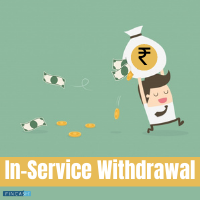
In-Service Withdrawal
What is In-Service Withdrawal?
In-service withdrawal is a term that refers to an employee taking a distribution from an employer-sponsored retirement plan without leaving the firm. An employee can take this benefit without wearing about tax penalty if the employee is above age 59 or if facing financial hardship.

However, in some cases, in-service withdrawals can be made without the occurrence of the event mentioned above. remember that not every retirement scheme allows in-service withdrawal however 70% of the retirement schemes in the US to offer this option with certain conditions.
In-service withdrawal rules allow an employee to take the distribution even for pursuing different investment options that they feel is suitable for them.
This provision can be a little tricky since it involves rolling over savings from a 401 K plan to a traditional IRA account.
For example, rolling over savings from a 401 K plan true to a traditional IRA account is legal if the money being transferred is from the employer’s contribution. Remember the money being rolled over cannot be a product of pre-tax contributions unless you are 59 years old or older. therefore the basic solution is to know what you precisely want and what your plan allows and does not allow. Getting these details might be a lot harder than it sounds.
Talk to our investment specialist
Important Points about In-Service Withdrawals
Usually, most withdrawal rules from a qualified employer-sponsored retirement plan come with a 10% early withdrawal penalty tax on the amount been given out. This tax is in addition to applicable federal Income in state Taxes. However, the 10% premature penalty tax can be waived if the in-service withdrawal is used in order to cover medical expenses the exceed adjusted gross income. the premature penalty tax can be waived also if there is a court-ordered payment order to a divorced spouse dependent or child.
All efforts have been made to ensure the information provided here is accurate. However, no guarantees are made regarding correctness of data. Please verify with scheme information document before making any investment.












